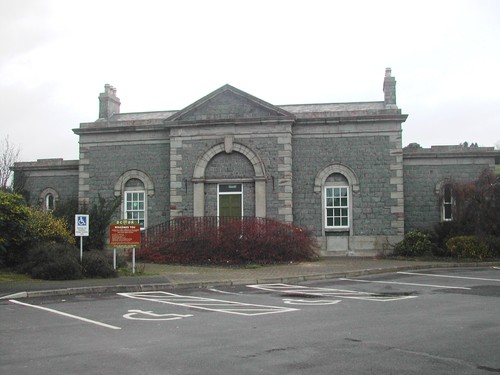Scrabo Sandstone
This popular building sandstone outcropped in the Dundonald and Newtownards area of County Down. Exposed quarry faces can still be seen in the South Quarry at Scrabo Tower, Newtownards, here dune-bedding, ripple marks and mudcracks with footprints of reptiles and trackways of ancient scorpions seen preserved in the stone. The name ‘Scrabo’ or ‘Scrabac’ means scraggy hill.
Scrabo occurs in a variety of colours, from warm, rich yellow, orange and deep red to paler grey and pink hues. The stone is laminated or ‘reedy’ as mason’s called it; the laminations are of finer clay and silt and can be contorted in many different ways. Clay also occurs as lenses or ‘clots’ throughout the stone.
This variation in colour and texture when used on a building creates a unique polychromatic mottled effect. This effect was very much appreciated in the 19th century and was used to construct many buildings in the Belfast area. As George Wilkinson stated in 1867, Scrabo Sandstone is,
‘properly used mixed, and after a little exposure to weather, the reed of the stone is exposed sufficiently to make one stone different from another’.
In 1872 when writing his treatise on British and Irish building stones, Edward Hull wrote,
“I know of no sandstone in the north of Ireland so well fitted for architectural purpose of an ornamental character”.
The sedimentary rocks exhibit stratification or bedding due to changing composition of the sediment and changing environmental conditions. In some blocks dune-bedding, and ripple marks can be seen.
The Scrabo Sandstone outcropping close to Newtownards has been modified during the eruption of the Antrim lavas 60 Million years ago and this gave rise to paler grey varieties of the building stone. Geological evidence shows that these desert sandstones were disturbed by explosions and intrusions of hot, molten magma. In fact, this is why the sandstone at the Scrabo Quarries is so well preserved, as a sill of black dolerite emplaced 60 Million years ago caps the sandstone and has protected it from weathering and erosion. The well preserved geological features in the South Quarry has afforded protection as a Special Site of Scientific Interest.
Microscopic View
Looking at a thin slice (30 microns thick) of the stone under a microscope shows quartz and feldspar grains cemented together with weak iron cements and calcite. In between and coating the grains clay minerals such as saponite and kaolinite occur. Saponite swells when wet and this expansion contributes to the decay of Scrabo stone when exposed to our cool damp climate.
The paler buff and grey sandstone close to the sill underwent changes due to the excess heat of the molten igneous rock. This is reflected in the accessory mineral assemblage of the stone that includes soft and fibrous needles of talc and actinolite visible in the pore spaces.
Scrabo Sandstone Quarries
The sandstone at Scrabo has been quarried since at least Anglo Norman times. The attraction of this particular sandstones to stonemasons was its variety of colours – white, buff and pink – and its relative ease of working. The stone was found to split relatively easily along bedding planes and the effect of the metamorphism had hardened some areas of the formation. Scrabo was found to be particularly suitable for intricate sculpture and carved detail.
One of the earliest examples of use was the ancient monastery at Greyabbey where the oldest structures date from the thirteenth century.
In 1683, William Montgomery in his survey of County Down wrote the following:
“Castle as appurtenances to the said Manor of Newtown is the high hill called Scrabo … and therein is the quarry of the best freestone that may be seen anywhere, if either durableness or smoothness and variety of green veins therein (when polished) be considered, ye stones whereof are well known in Dublin, and taken thither and elsewhere in great abundance”.
There are several quarries from which Scrabo was extracted. The best known are the quarries below Scrabo Tower the South and North Quarries and the boom period of the quarries was the nineteeth century when railway links were developed.
Other quarries that operated in the area were:
Glebe Quarry
Ballycullen Quarry– producing very uniform sandstone and the best performing of the Scrabo types in terms of durability, a good example being the Robinson and Cleaver building in Belfast
Ballyalton Quarry– a very pale variety the quarry was re-opened and used most recently in the early 1990’s for the restoration of Newtownards Town Hall















